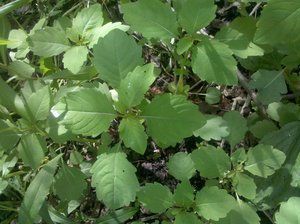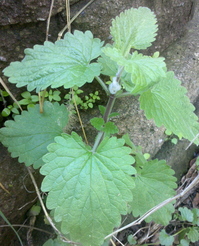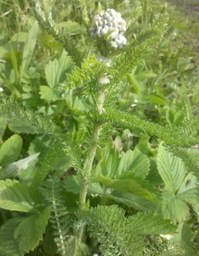Wildcrafting: Make your own mosquito repellant cheaply, simply from local plants

Jewelweed, Impatiens capensis, or touch-me-not, is found in wet areas, just like mosquitoes. The juicy crushed leaves applied to the skin help relieve the itch of a mosquitoes and other bug bites.
Linda Diane Feldt | Contributor
My least favorite remedy is to wear more clothes. I am always warm, year-round, so I welcome the chance to shed clothing in the summer. For many people long-sleeve shirts and pants and shoes works, but that just makes me miserable. So I need something more.
The “natural” bug sprays and lotions often contain citronella, tansy and pennyroyal. Other than being expensive and smelly, these work OK. Be careful of pennyroyal; the essential oil should not be used during pregnancy or on kids. Pennyroyal as an essential oil is very toxic, and had been used as a natural abortificant. Read the labels: Some chemical repellants add a few herbs and call it natural. But what if you want something even more effective, or if you forget to bring them with you?
You can make your own repellent very simply and cheaply, and from local plants. Catnip Nepeta cataria and yarrow Achillea millefolium are the two plants I rely on. An Iowa research group found that nepetalactone, the essential oil in catnip, is 10 times more effective than DEET. I’ve sent my catnip preparations with people traveling to Alaska, into the deep woods, to Michigan’s Upper Peninsula, and other places with fierce mosquitoes, and the reports come back very positive for its effectiveness.

Catnip can be more effective than DEET in repelling mosquitoes.
A tincture or oil made from yarrow flowers isn’t as strong as the catnip, but still out performs DEET. The variety with white flowers (wild yarrow) is the most effective. I like the smell better than catnip, but use both.
How can you make your own safe repellant? It can be as easy as carrying crushed catnip with you into the woods. I will confess to just bringing handfuls of catnip with me on walks, crushing the leaves to release the oil, and then braiding it into my hair, tucking it into my sleeves, and rubbing it onto my sandaled feet. It worked well, but had to be “recrushed” every 30 minutes or so.
Making either catnip or yarrow into an oil is the easiest method, and with one technique your repellant will be ready in just a few hours. For the catnip you can use plain leaves or the flowering tops. Yarrow needs the flowering tops. In this area, they are just starting to open this week. In a shallow baking pan, pour 1-2 cups of olive oil, depending on how much you want to make. Coarsely chop and the spread your leaves or flowering tops out in a shallow layer, so that they are submerged in the oil. Place in a low oven (200 degrees) for about 2-3 hours. I like to do this at night, so that the oven is on for a few hours and then I turn it off for the night and leave the pan in. In the morning I strain the oil in muslin cheesecloth (a coffee filter or dishcloth also work), compost the plant material, and store the oil in a glass jar in the refrigerator.
The long method is to fill a jar with the chopped plants, either catnip or yarrow flowers, fill with olive oil, and store for six weeks in a dark cool place. Be sure the jar and lid are very clean. After six weeks, strain and store the oil in the refrigerator.

Yarrow flowers can also be made into an effective mosquito repellent.
Linda Diane Feldt | Contributor
I fill small squeeze bottles (1-2 oz. bottles can be found at most camping stores) with the infused oil and take the bottle with me. The oil needs to be reapplied every 30-60 minutes we have found.
There is a great joke in rubbing catnip oil into my dog’s fur, but it works and she doesn’t mind. So far no cats have noticed.
Even better is to make an alcohol-based tincture. For this method, simply fill a small clean jar with the coarsely shopped yarrow flowers or catnip leaves and/or flowers. Don’t pack it tightly, just loosely place the plants. Fill the jar with 100 proof vodka. Put a lid on it, and put it in a cool dark place for six weeks. You can speed up this process by shaking the jar for a few minutes a couple times every day, and it will be ready in just two to three weeks.
After six weeks (or less if you have been shaking it regularly) strain off the herb-infused alcohol and compost the plants. The liquid tincture can then be diluted 50/50 with water, or even 75 percent water and 25 percent alcohol depending on how strong you want it. I put it into a spray bottle, and it keeps away mosquitoes as well as having a cooling effect.
Just like the oil, frequent reapplication is needed for it to keep working.
There is some anecdotal information that diet will affect your attractiveness to mosquitoes. Some people just taste better. A diet high in sugar seems to make people more of a target. I have a vivid memory of camping at Tahquamenon Falls in the UP one summer. I was bike camping with a friend, and the hordes of mosquitoes and black flies were amazing. A family came into the bathroom at the campground ravaged by mosquito bites. The mom and her kids were complaining loudly, and looking at me (free of bites) with suspicion. All the while drinking from a 2-liter bottle of full sugar pop. I delicately suggested there might be a link. The idea was considered briefly and then rejected.
My friend and I got a few bites, but they came and went with little effect. Biking hard every day (that was my first century ride), sweating profusely, drinking gallons of water, and staying away from sugar and fast food made us less of a target, I am certain.
When the mosquitoes are out in force, making foraging more difficult and unpleasant, I’m comforted by the fact that most of these obnoxious bugs will end up as food themselves. Watching the bats come out at dusk and swoop up 600-1,000 mosquitoes an hour (for each bat!) is a real pleasure. Birds, bats, fish, frogs and so many animals we enjoy depend on the mosquitoes for sustenance. I’m willing to suffer a bit, and am glad to have my homemade repellants to make being in the woods and near the water a pleasure all year-round.
Linda Diane Feldt is a Holistic Health Practitioner, Author and Teacher. You can reach her at ldfeldt(at)holisticwisdom.org, follow her on twitter, or find her website. A nearly complete listing of these blogs can be found here. Upcoming classes include a free class on local medicinal plants sponsored by The Peoples Food Co-op and hosted by Crazy Wisdom Bookstore, from 7-8:30 May 27. The first of three weed walks is this Sunday, the 23, from 1-3. There is a small fee, contact Linda Diane to register. The following weed walk is June 6, and then a free weed walk sponsored by the Huron River Watershed Council is June 12, contact the HRWC to register. A PDF of the handout we’ll use is available to download.


Comments
ed
Sun, May 23, 2010 : 8:37 a.m.
In one of Dr Gotts articles in Ann Arbor.Com it is suggested to take 500milligrams of brewers yeast daily to keep mosquitoes at bay. I plan on trying it. Possible unwanted side effects arre flatulence, cramps and diarreha to name a few.
mermaid72
Thu, May 20, 2010 : 7:34 a.m.
I'll give the catnip infusion a try. We live on a lake & near a swamp and I am unable to go out in the yard most of the summer. Mosquitoes are the bane of my life in the country, sometimes I must wear a hat with netting on it to work in the garden. Unlike the other poster here, I am more than willing to give your recipe a trial! LOL I appreciate your ideas and your writing style, they are excellent in both content and delivery.
Rork Kuick
Thu, May 20, 2010 : 7:11 a.m.
I'm just advising caution, particularly about reaching certainty about anything without science, whose main benefit is not in leading us to the truth, but in avoiding endless error. For example "Observation and experience, compiling information on herbal use for hundreds and in some cases thousands of years, is a practice I will defend" sounds like traditional Chinese medicine, or astrologers. I don't want to go there. This thinking gave us Ginko biloba, maybe the most widely used plant used to prevent age-related mental decline (according to Nutrition Business Journal G. biloba is about a 100 million dollar buisness in the U.S. alone), and used for centuries, but when we study it scientifically, we sadly get squat (PMID:20040554 was the JAMA paper of Dec 2009 that got so much press). Studies of goldenseal as an antibiotic, or the presumed effectiveness of echinacea for the common cold, also make me advise skepticism. Historic use of a herb is no evidence of it's effectiveness, and without evidence, prescribing or advocating it is the same as experimenting on human subjects without oversight (or proper consent), which is unethical in my world. I grant that nutrition, which seems like it should be so simple and common sense, is one of the most difficult area of medical research that I have ever seen.
Linda Diane Feldt
Wed, May 19, 2010 : 11:54 a.m.
@Rork, A fair question. But it raises many more. What is reasonable evidence? Studies on herbs are few and far between, most of the studies on common herbs are on trademarked preparations, often with multiple ingredients. There is little money in studying catnip and dandelions. But there are some, and the catnip DEET study was reported http://www.sciencedaily.com/releases/2001/08/010828075659.htm and there are many references to the use of catnip extract http://www.news-medical.net/news/2004/07/19/3401.aspx I will link to the original study when I have time later. I could report on studies and scientific findings, but writing about the studies of evidenced based herbology isn't my strong point, and it isn't my passion. I can read and understand a study. In my writings I've been careful to point to evidence, experience, and personal opinion. Example, the anecdotal observations in this article are not given as facts, but clearly labeled as personal experience and belief. Many of the studies are also using poorly prepared plants, plants taken at the wrong time, and given in non traditional ways. The results are all over the place for many herbs, Echinacea being a great example and St. John's Wort close behind. It is hard to find well doen research in general, and with hers in particular. If you read this and other posts, it is clear that I don't have a "from plants, must be OK" attitude. The last post I wrote was about pokeweed, and the emphasis is on its danger, precautions, and clearly stated that it would be unwise to use the plant medicinally based on information from a blog or the internet. In this post, I mentioned the dangers of pennyroyal extract, a warning not included on most of the preparations that contain it. If someone was following me and interested in a pure scientific approach, they would be frustrated. And there is certainly room for additional blogs that want to address the science of plants and their uses. This is also not a complete recording of everything there is to know about wild and medicinal foods. I can supply some more background when asked, but please don't blog that will cover every aspect. Is it worth writing about even if I can't do more extensive research and reporting? I think so, and the comments seem to indicate I'm not alone. Because of the limitations of this forum there are plants I will not write about. One example is mushrooms. Not only am I not expert enough. the risk of misinterpretation and mistakes are too high to risk it. There are hundreds of other plants I have also passed on. It just isn't the time and the place. For most of these plants, we are talking about using them as food and nourishment. No one is asking for scientific references before eating broccoli. And that is a fair comparison. I do agree that the greater the claim, the greater the need for evidence to back up that claim. And if there is a safety question, all the more so. But hypothesizing about mosquitoes and what attracts them seems pretty benign to me. Observation and experience, compiling information on herbal use for hundreds and in some cases thousands of years, is a practice I will defend as well as also welcoming the very new methods to gain evidence. But to discard or denigrate the use of herbs because they can not be studied as thoroughly as the drug companies can afford would be foolish. Please feel free to point out the weaknesses in my writing. That can be helpful and also presents a different - and certainly valid - point of view. I welcome the challenge to continue to be careful, think clearly, and present the information honestly. But I will not be writing and posting blogs that are equal to a scientific paper. This isn't the time or the place, and I'm not the right person.
Rork Kuick
Wed, May 19, 2010 : 11 a.m.
I have been tempted many times to comment that what gets stated in your articles often fails miserably when it comes to pointing to any shred of evidence. The two paragraphs ending in "Im certain that is what made us less of a target." finally made me comment. I can find "some anecdotal evidence" to almost anything imaginable, even homeopathy. Why not cite your yarrow and catnip papers too? For example, perhaps they would indicate if the substances are safe or not, which I hope is a major question, but it was not addressed here at all. Is there a "from plants, must be OK" attitude?